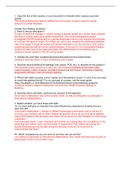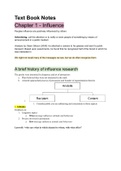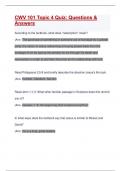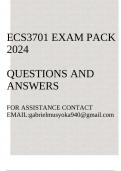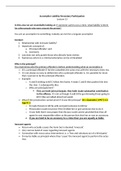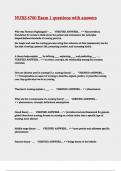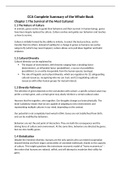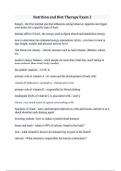RT samenvatting 1.2d
Side effect
- A side effect is an affect, whether therapeutic or adverse, that is secondary to the one
intended; although the term is predominantly employed to describe adverse effects.
Radiobiology
- Is a field of clinical and basic medical sciences that involves the study of the action of ionizing
radiation on living things, especially health effects of radiation.
Influences
- Exceeding tolerance dose of tumor (> D = treatment)
- Exceeding tolerance dose healthy tissue (> D = adverse reaction)
- 5R’s of radiotherapy (nowadays 6R’s)
- Fractionation schemes
o Hyper/ hypofractionation
- Physical vs biological dose.
- If we exceed this tolerance dose, we cause an adverse reaction, a side effect. This can be an
acute side effect (occurring during treatment) or a delayed effect (sometimes even years
after completion of treatment.)
Radio sensitivity – how sensitive cells are to radiation effects;
- Repair: how well are certain cells (tissues) capable of repairing damage?
- Repopulation: this is a type of tumor defense mechanism to defend itself.
- Redistribution: tumor cells rearrange into a treated tumor.
- Reoxygenation: the presence or absence of oxygen plays an impotant role in the effect of
our irradiation.
- Reactivation of immune response
Radiosensitivity
- Radiation sensitivity of the tissue affects tolerance dose (how sensitive cells are to radiation
damage.)
- Depends on:
o Tissue type
o Radiation type and quality (LET = linear energy transfer)
o Volume
o Cell cycle phase; the phase in which the cell is in his division cycle also has an
influence; not in every phase a cell is equally sensitive to radiation
- Fractionation scheme
, Tolerance dose
- The higher the fraction dose, the greater the effect on tissue. Fit is referred to as the
radiobiological effect and is linked to the radiobiological dose, which is somewhat different
from radio physical dose.
The phases
G0 = The cell is at rest and no division takes place.
G1 = By a signal from the DNA, the cell is switched on to proliferate (multiply)
S phase = in this step data synthesis takes place and the chromosome strands are doubled. In
preparation for cell division.
- When the cell is in the G0, G1 or S-phase, the cell is the least sensitive to damage.
G2 = After the chromosome doubling the cell enters the G2 phase. In this phase the cell contains the
most DNA and prepares for the final division.
M phase = also called mitosis phase, the cell eventually starts to divide.
- In the G2 and M phase cells are the most sensitive for irradiation.
Survival curves and LET
- Increasing LET:
o Increase steepness of survival-curve
o Results in more linear curve
- Linear energy transfer (LET) is the amount of energy that an ionizing particle transfers to the
material travers per unit distance. It describes the action of radiation into matter.
- Each type of radiation has its own LET. For example a-particles have a very high LET value,
these particles release their energy almost immediately.
- Photonic radiation, has a much lower LET value.
- Photons emit much less energy per road travelled.
o Photons have an indirect effect.
- With an increase of the LET we see an increase of the steepness of the survival curve of the
cells. this means that at lower doses we can do a lot of damage to cells, because of the
high energy transfer.
- What we also see with an increase of LET is that the dose effect relationship becomes more
linear.
Side effect
- A side effect is an affect, whether therapeutic or adverse, that is secondary to the one
intended; although the term is predominantly employed to describe adverse effects.
Radiobiology
- Is a field of clinical and basic medical sciences that involves the study of the action of ionizing
radiation on living things, especially health effects of radiation.
Influences
- Exceeding tolerance dose of tumor (> D = treatment)
- Exceeding tolerance dose healthy tissue (> D = adverse reaction)
- 5R’s of radiotherapy (nowadays 6R’s)
- Fractionation schemes
o Hyper/ hypofractionation
- Physical vs biological dose.
- If we exceed this tolerance dose, we cause an adverse reaction, a side effect. This can be an
acute side effect (occurring during treatment) or a delayed effect (sometimes even years
after completion of treatment.)
Radio sensitivity – how sensitive cells are to radiation effects;
- Repair: how well are certain cells (tissues) capable of repairing damage?
- Repopulation: this is a type of tumor defense mechanism to defend itself.
- Redistribution: tumor cells rearrange into a treated tumor.
- Reoxygenation: the presence or absence of oxygen plays an impotant role in the effect of
our irradiation.
- Reactivation of immune response
Radiosensitivity
- Radiation sensitivity of the tissue affects tolerance dose (how sensitive cells are to radiation
damage.)
- Depends on:
o Tissue type
o Radiation type and quality (LET = linear energy transfer)
o Volume
o Cell cycle phase; the phase in which the cell is in his division cycle also has an
influence; not in every phase a cell is equally sensitive to radiation
- Fractionation scheme
, Tolerance dose
- The higher the fraction dose, the greater the effect on tissue. Fit is referred to as the
radiobiological effect and is linked to the radiobiological dose, which is somewhat different
from radio physical dose.
The phases
G0 = The cell is at rest and no division takes place.
G1 = By a signal from the DNA, the cell is switched on to proliferate (multiply)
S phase = in this step data synthesis takes place and the chromosome strands are doubled. In
preparation for cell division.
- When the cell is in the G0, G1 or S-phase, the cell is the least sensitive to damage.
G2 = After the chromosome doubling the cell enters the G2 phase. In this phase the cell contains the
most DNA and prepares for the final division.
M phase = also called mitosis phase, the cell eventually starts to divide.
- In the G2 and M phase cells are the most sensitive for irradiation.
Survival curves and LET
- Increasing LET:
o Increase steepness of survival-curve
o Results in more linear curve
- Linear energy transfer (LET) is the amount of energy that an ionizing particle transfers to the
material travers per unit distance. It describes the action of radiation into matter.
- Each type of radiation has its own LET. For example a-particles have a very high LET value,
these particles release their energy almost immediately.
- Photonic radiation, has a much lower LET value.
- Photons emit much less energy per road travelled.
o Photons have an indirect effect.
- With an increase of the LET we see an increase of the steepness of the survival curve of the
cells. this means that at lower doses we can do a lot of damage to cells, because of the
high energy transfer.
- What we also see with an increase of LET is that the dose effect relationship becomes more
linear.


